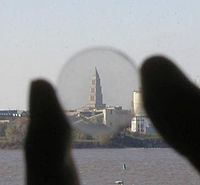
Photo from wikipedia
Abstract Understanding and establishing the relationship between the microstructure of high density polyethylene (HDPE) resins and their mechanical behavior is critical in designing new products and catalysts to produce these… Click to show full abstract
Abstract Understanding and establishing the relationship between the microstructure of high density polyethylene (HDPE) resins and their mechanical behavior is critical in designing new products and catalysts to produce these polymers. Recent advancement in the mid-infrared (IR) spectroscopic imaging techniques combined with intuitive mathematical modelling can provide a powerful tool in solving this industry-wide long-standing challenge. In this work, IR spectral anisotropy methods coupled with the Crystal Tie Mesh (CTM) model were used to examine the effects of various resin architectures (monomodal and bimodal) on the bulk strain hardening moduli in cold drawn HDPE samples. Using a polarized laser for IR imaging, the related stress strain profiles of local strain gradients (100% sample strain) were modelled using a modified Eyring algorithm. A clear correlating trend was found between a resulting structural parameter in this algorithm (β) and the bulk strain hardening moduli for all samples studied. Results show that the more stable the molecular network (e.g., the lamella segments connected via bridging entanglements and tie molecules), the less strain is observed (i.e. higher β values) when a load is applied. The observed structural effects on the β parameter are consistent with previous results obtained using the CTM model that views the system to be a type of cross linked network formed by multiple bridging and entangled tie chains through common crystalline lamella.
Journal Title: Polymer
Year Published: 2019
Link to full text (if available)
Share on Social Media: Sign Up to like & get
recommendations!